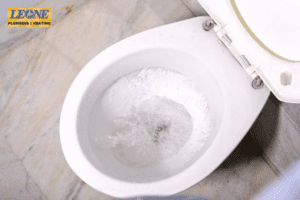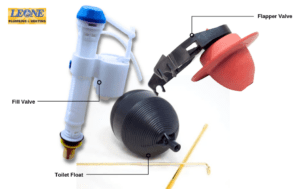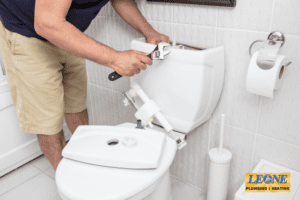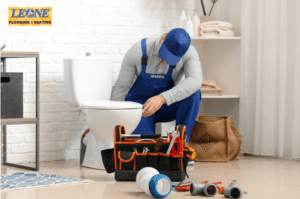Why Your Toilet Keeps Running and How to Fix It Fast

Is your toilet running non-stop and keeping you up at night? If your toilet keeps running, it’s more than just a nuisance—it can waste a lot of water and increase your water bill. That’s why fixing it promptly is crucial. Whether you’re a DIY pro or tackling this for the first time, our step-by-step guide will help you quickly identify and resolve the issue.
From checking the flapper valve to adjusting the water level in the tank, we’ll cover all the common causes of a running toilet and provide easy-to-follow solutions. You don’t need to be a plumber to solve this frustrating issue – just grab your tools and get ready to put an end to that constant running water. Don’t let a running toilet disrupt your peace of mind any longer – let’s get started!
Common Causes Why A Toilet Keeps Running

A constantly running toilet can be a nuisance, and understanding the common causes can help you diagnose the issue effectively. One of the primary culprits is a malfunctioning flapper valve. The flapper is a rubber or plastic component located at the bottom of the toilet tank that seals the opening to the toilet bowl. If it’s worn out, warped, or improperly seated, water will continuously leak from the tank into the bowl, resulting in a persistent running sound. This often goes unnoticed, but it’s a frequent cause of water wastage.
Another common cause is the fill valve, which controls the flow of water into the tank after a flush. If the fill valve is defective or clogged, it can lead to an overfill situation where water spills into the overflow tube. This can create a constant flow of water that keeps the toilet running. Regular wear and tear on the internal components of the toilet can lead to various issues, and it’s essential to inspect these parts regularly to ensure they function correctly.
Lastly, the float mechanism, whether it’s a float ball or a float cup, plays a crucial role in regulating the water level in the tank. If the float is set too high, it can cause the fill valve to remain open, leading to a running toilet. Adjusting the float mechanism is often a simple fix that can stop the running water immediately. By understanding these common causes, you can effectively troubleshoot and resolve the issue before it becomes a more significant problem.
The Importance Of Fixing A Running Toilet
Addressing a running toilet is crucial for the following reasons.
It Can Lead to Significant Water Wastage
If your toilet keeps running, it can waste hundreds of gallons of water each month, leading to higher water bills and unnecessary environmental impact. This issue becomes even more concerning during the summer when water consumption increases for gardening and outdoor activities. Addressing the problem promptly can help you save money and conserve this valuable resource.
A Running Toilet Can Indicate Other Underlying Issues Within Your Plumbing System
Ignoring this problem may lead to more severe plumbing issues down the line, such as corrosion, leaks, or even damage to your bathroom flooring. By taking the time to troubleshoot and resolve the running toilet, you can prevent more costly repairs in the future. Maintaining your plumbing fixtures properly ensures a more efficient and reliable home plumbing system.
A Constantly Running Toilet Can Be A Frustrating Distraction That Disturbs Your Peace of Mind
The sound of running water can be especially bothersome during quiet moments or when you’re trying to unwind. Fixing the issue brings back a sense of calm to your bathroom. A properly functioning toilet is key to a comfortable home, and addressing the problem promptly can improve your overall living experience.
How To Identify If Your Toilet Keeps Running
Identifying whether your toilet keeps running can be easily accomplished with a few simple observations. By staying alert to the following signs, you can quickly identify and fix a running toilet, preventing water waste and unnecessary expenses.
Listen for Unusual Sounds
- A continuous hissing or dripping sound from the tank indicates a problem.
- The sound of water running, even when the toilet isn’t in use, is a key warning sign.
- Water trickling into the bowl is another clear indication of a malfunction.
Perform a Visual Inspection
- Remove the toilet tank lid and observe the components.
- If the water level drops and the fill valve activates frequently, the toilet is running.
- Conduct a dye test: Add a few drops of food coloring to the tank—if color appears in the bowl after 15-20 minutes without flushing, there’s likely a leak.
Check Your Water Bill
- A sudden spike in your water bill without increased usage could indicate a running toilet.
- Monitoring your water consumption can help catch the issue before it worsens.
Steps to Troubleshoot If Your Toilet Keeps Running

Troubleshooting a running toilet is a straightforward process that can save you time and money. Start by gathering the necessary tools, which typically include a pair of adjustable pliers, a screwdriver, and possibly a replacement flapper or fill valve, depending on what you find during your inspection. Once you have your tools ready, you can begin the troubleshooting process by carefully examining the toilet components.
The first step is to check the flapper valve. Lift the tank lid and inspect the flapper for any signs of wear, such as cracks or deterioration. If the flapper appears damaged, you’ll need to replace it. Removal is simple; just unhook it from the chain and lift it off the flush valve. Install the new flapper by following the same steps in reverse, ensuring that it seals properly. After making the replacement, flush the toilet to see if the running issue has been resolved.
Next, you’ll want to check the fill valve. Adjust the float to ensure it is set correctly; if it’s too high, the valve may not shut off, causing the toilet to run. To adjust the float, locate the adjustment screw on the fill valve and turn it clockwise to lower the float level. If adjusting the float doesn’t solve the problem, the fill valve may need replacing. Turn off the water supply, flush the toilet to empty the tank, and follow the manufacturer’s instructions for removing and installing a new fill valve. After making these adjustments, monitor the toilet for any further signs of running water.
Checking and Adjusting the Flapper Valve
The flapper valve is a critical component in your toilet that can often be the source of a running issue. To check the flapper, first, remove the lid of the toilet tank and observe its condition. Look for signs of wear, such as cracks or warping, which can prevent it from sealing properly. If the flapper appears to be in good shape, ensure it is correctly aligned and not stuck open. Sometimes, debris can prevent it from closing completely, leading to a running toilet. Cleaning the area around the flapper can often remedy this situation.
If you determine that the flapper is indeed faulty, replacing it is a relatively simple task. Start by draining the tank by turning off the water supply and flushing the toilet. Once the tank is empty, unhook the flapper from the chain and remove it from the flush valve. Take the old flapper to a hardware store to find an exact match or a compatible replacement. Installing the new flapper is just as easy: attach it to the flush valve, connect the chain, and ensure it has enough slack to allow for a full flush.
After replacing or adjusting the flapper, it’s essential to test the toilet’s functionality. Turn the water supply back on and allow the tank to fill. Afterward, flush the toilet and listen for any signs of running water. If the toilet is now silent and functioning properly, you’ve successfully resolved the issue. However, if the toilet continues to run, further investigation into other components may be necessary.
Adjusting the Fill Valve
The fill valve plays an essential role in the toilet’s flushing mechanism by controlling the flow of water into the tank. If your toilet is running, adjusting the fill valve may be a necessary step in addressing the issue. Start by locating the fill valve in your toilet tank. It is typically positioned on the left side and connected to the water supply line. Like the flapper, the fill valve can also wear over time, leading to malfunctions that can cause a running toilet.
Observe the water level in the tank as it fills. There should be a marked line indicating the appropriate water level, usually about an inch below the top of the overflow tube. If the water level rises too high and spills into the overflow tube, it indicates that the fill valve needs adjusting. To adjust the fill valve, first, turn off the water supply to the toilet. This is usually done by turning the shut-off valve located on the wall behind the toilet. Once the water is off, flush the toilet to drain the tank.
Many modern fill valves come with an adjustment screw or a mechanism that allows you to raise or lower the float. If your fill valve has a screw, turn it clockwise to lower the float, which reduces the water level. If it has a float cup, gently push the float down to lower the water level. Once you’ve made the necessary adjustments, turn the water supply back on and allow the tank to fill. Observe the water level and flush the toilet to ensure it no longer runs. If issues persist, it may indicate that the fill valve needs replacement.
Checking and Adjusting the Float Ball or Float Cup
The float mechanism in your toilet is vital for regulating the water level in the tank. Depending on the model of your toilet, you may have a float ball or a float cup. A float ball is a buoyant device attached to a long arm, while a float cup is integrated into the fill valve assembly. If either of these is misadjusted, it can lead to a constantly running toilet. Begin by checking the float’s position; it should rise and fall freely with the water level.
For toilets with a float ball, check to ensure that the ball is not waterlogged or damaged. If it has become heavy and no longer floats, it will fail to shut off the fill valve, causing a running toilet. In this case, you’ll need to replace the float ball. If the float ball is in good condition, you can adjust its height by bending the arm slightly downward, which will lower the float and allow the fill valve to shut off sooner.
If your toilet has a float cup, ensure it moves freely along the fill valve shaft. To adjust the float cup, locate the adjustment mechanism, which could be a clip or a screw. If it’s a clip, you can slide it up or down to change the height of the float. For a screw mechanism, turning it can raise or lower the float cup as needed. After making these adjustments, turn the water supply back on and test the toilet to ensure it stops running. This simple yet effective check can often resolve the issue and restore your toilet’s functionality.
Other Possible Causes and Solutions for a Running Toilet
While the flapper, fill valve, and float mechanism are the most common causes of a running toilet, there are other potential issues to consider. For instance, a malfunctioning overflow tube can lead to constant running. If the water level in the tank is too high, it can spill into the overflow tube, causing the fill valve to remain open. Ensure the overflow tube is not cracked and that the water level is set correctly, ideally about an inch below the top of the tube.
Additionally, sediment buildup in the fill valve can cause issues with water flow. Over time, minerals from hard water can accumulate and clog the valve, preventing it from shutting off properly. If you suspect this is the case, you may need to disassemble the fill valve and clean it thoroughly to remove any debris. This can often restore its function without needing a full replacement.
Finally, in some instances, the toilet tank itself may develop cracks or leaks that cause water to escape at a steady rate. Inspect the tank for any visible signs of damage or deterioration. If you discover cracks, it may require replacing the entire tank or the toilet itself, as repairs for such issues can be quite challenging. By being aware of these additional causes, you can navigate the troubleshooting process more effectively and ensure your toilet operates efficiently.
When To Call A Professional Plumber
While many issues can be resolved with basic troubleshooting, there are times when calling a professional is the best option—especially if your toilet keeps running despite your efforts to fix it. If you’ve gone through the troubleshooting steps and the problem persists, it may indicate a deeper plumbing issue that requires expert attention. Persistent leaks or multiple toilets experiencing similar problems could be signs of an underlying concern that needs professional intervention.
Additionally, if you’re uncomfortable making adjustments or repairs yourself, seeking professional help is a smart choice. Plumbing repairs can be complex, and attempting them without the proper knowledge could lead to further damage or costly mistakes. A licensed plumber can accurately diagnose why your toilet keeps running, provide effective solutions, and ensure everything is functioning properly.
If your toilet keeps running and DIY fixes aren’t solving the problem, it may be time to call a professional. Leone Plumbing & Heating is a trusted team of licensed plumbers in Rochester, NY, ready to provide expert solutions. Persistent leaks and ongoing toilet issues can lead to higher water bills and potential plumbing damage, so addressing them promptly is essential. We take pride in delivering top-notch service throughout the Rochester, NY area, ensuring your plumbing system runs smoothly. Contact us here at Leone Plumbing & Heating today for reliable, professional assistance and get your toilet fixed the right way!
